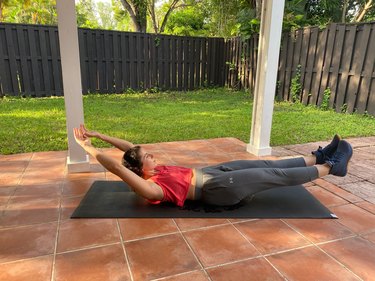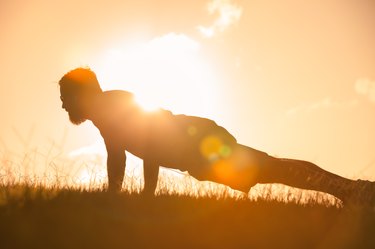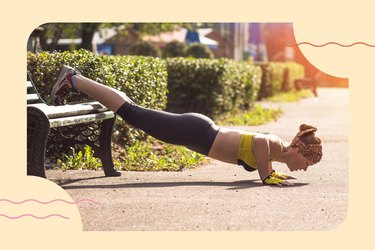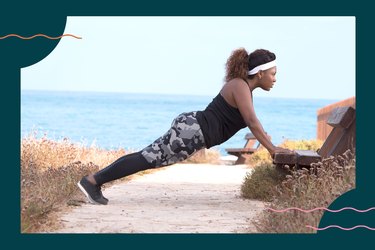
Push-ups are staple exercise for a very good reason: They activate multiple major muscles all up and down the front and back of the torso.
But if you're trying to strengthen your back muscles, push-ups can help when you make certain adjustments. Keep in mind that no push-up will comprehensively train this area, however.
Video of the Day
Ahead, learn how to do a push-up with proper form, plus benefits and tips that can help strengthen your back muscles.
How to Do a Push-Up With Proper Form
- Position yourself on your hands and knees, hands under shoulders and knees under hips.
- Step your feet back and straighten your legs so that you're balanced on your palms and toes.
- Your body should make a straight line from head to hips to heels, and your hands should be directly under your shoulders or slightly wider apart.
- Bend your elbows at a 45-degree angle to your body and lower your body to the floor.
- Make sure to keep your body in one straight line from the neck through the spine to the hips and down to the heels.
- Press into your palms and push the floor away from you to come back up to a high plank, still keeping your body in one straight line.
Do Push-Ups Work Your Back Muscles?
Yes, push-ups work your upper and lower back muscles, according to the American Council on Exercise (ACE).
The standard push-up doesn't work the latissimus dorsi, or "lats," which are the muscles under your shoulder blades. But they do work your back extensor muscles (erector spinae) that run the length of the spine on either side, allowing you to stand upright and rotate our trunks.
When doing push-ups, keeping your shoulder blades pulled back increases the activation of your rhomboid and trapezius muscles located in your upper back.
In addition to your back, push-ups also target the following muscles, per ACE.
- Pectorals (chest)
- Deltoids (shoulders)
- Biceps (front of upper arms)
- Triceps (back of upper arms)
- Abdominals (stomach)
Push-Up Benefits
There are a few major benefits of push-ups. Here's why you should include this exercise in your regular exercise routine.
1. They Strengthen Many Major Muscle Groups
As we mentioned above, push-ups work your back, chest, shoulders, arms and abs. Having strong muscles not only makes your workouts easier, but activities in your daily life, too. For instance, you'll be more able to lift heavy boxes, groceries, kids and pets with more powerful upper-body muscles.
2. They Boost Heart Health
Yes, doing all forms of cardio and strength training on a regular basis is good for your heart, per Johns Hopkins Medicine. But research has linked push-up capacity, in particular, to a lower likelihood of heart disease.
In a a February 2019 study published in JAMA Network Open, researchers found that men who could do 40 push-ups in one go had significantly lower risk of heart disease over the course of 10 years compared to those who could do fewer than 10 push-ups.
It's worth noting men were the only participants in this study and more research is needed to see how push-up capacity affects heart disease risk in other sexes.
3. They Support Bone Health
Weight-bearing exercises, like push-ups, can help you build strong bones. Strong bones can reduce your risk of fractures and conditions like osteoporosis (where your bones become weak and brittle), according to the Mayo Clinic.
FAQ
Common Questions
How many push-ups a day will help build back muscle?
If building muscle is your goal, you should perform 3 to 4 sets of 6 to 12 reps of push-ups on a given day, according to the National Academy of Sports Medicine (NASM). It's important to let your muscles rest so they have time to repair and rebuild stronger, so it's not recommended to do push-ups every day.
Which type of push-up is best for back?
Standard push-ups work your back extensor muscles (erector spinae) that run the length of the spine on either side, allowing you to stand upright and rotate our trunks. When doing push-ups, make sure you keep your shoulder blades pulled back to increase the activation of your rhomboid and trapezius muscles located in your upper back.
- ACE: "What Muscles Do Pushups Work? Tips How To Do Them Correctly"
- Johns Hopkins Medicine: "3 Kinds of Exercise That Boost Heart Health"
- JAMA Network Open: "Association Between Push-up Exercise Capacity and Future Cardiovascular Events Among Active Adult Men"
- Mayo Clinic: "Bone health: Tips to keep your bones healthy"
- NASM: "The Optimum Performance Training Model"
Was this article helpful?
150 Characters Max
0/150
Thank you for sharing!
Thank you for your feedback!



